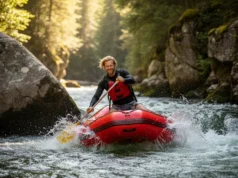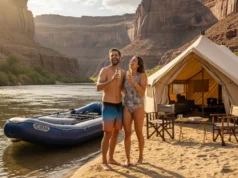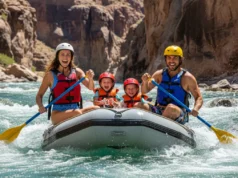In this article
Standing at the river’s edge, the roar of the first rapid echoing off canyon walls. You’ve seen the glossy brochures and five-star reviews, but as you pull on the life vest, a question surfaces: how do you really know you’re safe? This guide moves beyond the marketing facade, transforming you from a passive passenger into a safety-conscious participant. We will equip you with a field-tested framework to decode the subtle red flags and definitive green lights of any rafting company, turning your choice into a confident, informed decision. This is your guide to understanding rafting company red flags.
Together, we’ll cover the essential intelligence you can gather from home, analyzing a company’s permits, guide training and certification. We’ll walk through the day-of due diligence, teaching you how to read the on-site signs of professionalism in the equipment quality and, most importantly, in the thoroughness of the safety talks. We’ll even look at the human element, spotting the hidden dangers of a toxic workplace culture. Finally, you’ll see how your own preparation and attention are a vital component of a successful river trip. This is your journey from consumer to competent partner on the water.
The Pre-Trip Investigation: How to Vet an Outfitter from Home
Your risk assessment begins long before you feel the first splash of river water. Gathering critical intelligence from home allows you to filter out questionable operations and book with confidence. This is about looking past the customer reviews to find verifiable credentials and proof of legal compliance that speak volumes about a company’s commitment to your well-being.
Are They Operating Legitimately? Decoding Permits and Regulations
Before a single raft touches the water, a professional rafting business navigates a complex world of permits and regulations. This isn’t just paperwork; it’s the foundational layer of oversight that separates legitimate businesses from rogue operators. For many of the classic river trips in the U.S., whether on the Arkansas River near Salida, Buena Vista, and Canon City or the Colorado River through Grand Canyon National Park, river outfitters must hold land use permits from federal agencies like the Bureau of Land Management (BLM), the U.S. Forest Service (USFS), or the National Park Service. Securing these permits requires companies to submit detailed operating plans, prove they carry liability insurance, and demonstrate a history of professionalism and solid company experience. The number of years in business is a key indicator. This process itself filters out the disorganized and unprepared.
These federal permits come in different forms, each telling a story about the company’s stability. A short-term Commercial Use Authorization (CUA) might be granted for a season, but a long-term, highly competitive Concession Contract—like those required to operate in the Grand Canyon—signifies years of proven experience and deep organizational commitment. The first major green flag you can find is a company that proudly displays its status as a licensed permittee. It’s a clear signal they’ve met a high bar of scrutiny. While federal permits provide a strong baseline, state-level regulations can vary wildly, creating a patchwork of standards across the regulated rafting industry. This makes it critical not to take “licensed” at face value but to see it as one piece of a four-pillar framework to vet rafting outfitters. The real red flag is a company that can’t clearly articulate its guide training standards or seems to default to the bare minimum required by law.
| Snapshot: State Guide Regulations | ||||
|---|---|---|---|---|
| Requirement | Maine | Washington | Colorado | Oregon/Idaho |
| Minimum Guide Age | Not Specified (18+ implied) | 18 years | Not Specified | Not Specified |
| First Aid / CPR | Required (Standard First Aid & CPR) | Required (Lifesaving Training Course) | Documented by Outfitter | Required (Basic First Aid/CPR) |
| Specific Training Runs | 20+ runs for Level I; 10+ additional for Level II | 1 run on river section before guiding it | Documented by Outfitter | Documented by Outfitter |
| State-Administered Exam | Written Exam Required | No | No | No |
| Instructor Qualifications | Licensed Whitewater Guide Trainer | 1,500 river miles (750 as guide) | Documented by Outfitter | Not Specified |
| Primary Regulatory Focus | Individual Guide Licensing (Tiered) | Outfitter & Guide Minimums | Outfitter Licensing | Outfitter/Guide Registration |
What is the Quality of Their Training and Certifications?
Beyond permits, the qualifications of the river guides themselves are the core of a company’s safety net. A long-standing company where inexperienced operators may raise red flags is a definite concern. Every guide should have standard First Aid & CPR, but on a waterway, where help can be hours away, that’s just the starting point. The two credentials that truly separate the professionals from the part-timers are Swiftwater Rescue (SWR) and Wilderness First Responder (WFR). SWR is a specialized, physically intensive certification from a rigorous training program that teaches guides how to perform complex rescues in moving water. A green flag is an outfitter that not only requires SWR for its guides—including any first-year guides—but actively incentivizes it, separating them from the merely adequate.
Even more telling is a company’s commitment to the “Gold Standard” of remote medical training: Wilderness First Responder (WFR). This is not your standard weekend first aid class; it’s an intensive, 70-80 hour course that dwarfs other certifications. The Wilderness First Responder curriculum is specifically designed for long-term patient care and difficult evacuation decisions. This leads to one of the most important questions to ask before booking: “What percentage of your trip leaders are WFR certified?” Their answer is a direct proxy for their entire risk management philosophy. A high percentage indicates they prepare for worst-case scenarios and have a high risk tolerance. A low percentage, or worse, an inability to answer the question, is a major red flag. This knowledge of advanced training connects directly to the tools they carry; a well-trained guide knows exactly how to assemble a trip-specific swiftwater rescue system.
Pro-Tip: When you ask about WFR certification, listen for the details. A great answer sounds like, “All of our trip leaders are WFRs, and we require all guides to achieve it within two seasons.” A hesitant answer like, “Our guides are first-aid certified,” is a sign they are operating at a minimum standard.
Day-Of Due Diligence: Reading the On-Site Signs
You’ve done your research and booked the trip. Now, on the day of your rafting excursion, your investigation moves from the digital world to the physical. The equipment a company provides and the briefing they deliver are the most tangible evidence of their safety practices. This is your chance to see their philosophy in action.
Does Their Equipment Signal Professionalism or Neglect?
Pay close attention, starting with the single most important piece of rafting gear: the personal floatation device (PFD), or life jacket. Legally, an outfitter can give you a basic Type III PFD, but the industry best practice is a Type V “Commercial Whitewater Vest.” The difference is stark. A Type V vest offers higher buoyancy, a more secure fit, durable construction, and rescue-specific features. An outfitter using generic, worn-out Type III vests is signaling a “minimum standards” approach. Top-tier outfitters like Raft Masters or Echo Canyon River Expeditions use updated equipment that is USCG-approved gear, and their commitment to quality is obvious. For a deeper look, refer to the official United States Coast Guard PFD selection and use guide, but the visual difference alone will tell you much about what you need to find in the perfect rafting PFD. Other important inclusions to check are the condition of wetsuits, river boots, and splash jackets.
Expand your gear check to the entire operation. The rafts should be clean and have undergone proper safety checks, a sign of good sanitation standards, not covered in faded patches or made of spongy, sun-rotted material. Ancillary gear like helmets should be free of major cracks, and paddles should have intact T-grips. Even the company vehicles and the boathouse tell a story; well-maintained transport and a tidy facility reflect a professional, well-managed company. Dilapidated equipment is a massive red flag suggesting unsafe conditions.
How Thorough and Professional is the Safety Briefing?
The most critical communication of the day is the pre-trip safety briefing, often called the “paddle talk.” This is a non-negotiable hallmark of a professional operation and a key part of their emergency procedures. A rushed, incomplete, or casually delivered briefing is one of the most serious safety issues you can encounter. A professional briefing will cover both “In-Boat” and “Out-of-Boat” scenarios. Pay close attention to the trip details they provide; a flexible takeout time is often a good sign, whereas a rigid one might indicate a rushed, low-quality service. Also, observe the boat capacity; overcrowded boats are a yellow flag that suggests cost-cutting.
The “In-Boat” components are your foundational commands. Your boatmen must clearly explain how to sit securely, what paddle commands mean, and what emergency commands like “High-side” are for. Understanding these verbal cues is essential, and a good outfitter wants to ensure you know the language of the river. If you want to study ahead, you can find a guide that deciphers every rafting command.
Critically, the briefing must detail the “Out-of-Boat” scenarios, including the “defensive swimmer’s position.” And it must include the single most important warning: NEVER stand up in moving current. The risk of foot entrapment is severe and entirely preventable. The briefing must also cover how to receive a throw rope, how your crew will pull you back into the boat, and what to do in the event of a capsized raft. A company that glosses over these details, or has unclear policies on guest experiences like rock jumping or swimming rapids, is not prioritizing your safety.
The Hidden Danger: Assessing Company Culture
While operational procedures and gear are visible, the invisible workplace culture of a company can pose an even greater risk. Safety concerns linked to issues like sexual harassment policies, burnout, and hazing practices are not just internal problems; they create a hostile work environment that leads to tangible dangers on the river.
Does the “Cowboy Culture” Compromise Professionalism?
The rafting industry has a historical “work hard, play hard” ethos that, when unhealthy, can blur professional boundaries. This “cowboy culture” can sometimes foster a toxic environment. A landmark investigation of harassment and hostile work environment by the U.S. Department of the Interior within the Grand Canyon river district uncovered systemic sexual misconduct. This is not an isolated problem; public company warnings and firsthand accounts from places like the Ocoee River, with some companies like Outdoor Adventure Rafting (OAR) facing serious allegations of criminal activity and creating a hostile work environment, show this is a widespread issue in the white-water rafting industry. For customers, this is not an HR matter—it is a critical safety issue, especially for female guides and guests.
You can often observe the signs of a toxic culture. Listen for inappropriate jokes or discrimination. Watch for a visible lack of respect between guides. An overt party atmosphere that overshadows professional duties is a glaring red flag, as are poor living conditions in guide housing, which can breed resentment and unprofessionalism. Some reports have cited OSHA violations related to things like black mold or poor sanitation standards that don’t follow bodily fluid protocols. A workplace that tolerates disrespect is likely to have a diminished regard for rules and procedures, leading to a communication breakdown when it matters most.
Pro-Tip: During the gearing-up process, discreetly observe how the guides interact with each other. Do they work as a seamless team, communicating with respect and efficiency? Or is there tension, dismissiveness, or unprofessional chatter? The way they treat each other is often a direct reflection of how they’ll handle pressure on the river.
Conclusion
Your journey to becoming a more competent and confident rafter starts with informed choices. We’ve seen that the most reliable companies are those who exceed minimal standards by demonstrating significant company experience, holding multi-year federal permits, and investing in advanced guide training & certification like WFR and SWR. Their commitment is visible in their equipment quality, choosing industry-best-practice Type V PFDs over their lesser counterparts. Their professionalism is audible in the thorough, clear safety briefing that explicitly warns against standing in moving current. Finally, their integrity and company reputation are evident in a positive workplace culture, because a company that tolerates harassment is a safety liability. Use this framework on your next rafting company adventure to continue transforming your knowledge into instinct.
Frequently Asked Questions about Choosing a Safe Rafting Company
What is the single most important question to ask a rafting company before booking?
Ask, “What percentage of your trip leaders hold a Wilderness First Responder (WFR) certification?” This question probes the core of their risk management philosophy and reveals whether they prepare for minor incidents or worst-case scenarios.
Is a company having “licensed guides” enough to ensure safety?
No, because state licensing standards vary dramatically from highly rigorous to virtually non-existent. You must inquire about the company’s specific internal training requirements, such as the number of on-river training runs their experienced guides complete with new hires.
What is a major red flag regarding the PFD (life jacket) I’m given?
A major red flag is being issued a generic, worn-out Type III PFD instead of a whitewater-specific, USCG-approved Type V personal floatation device. Type V vests offer higher floatation and rescue-oriented features, and their use indicates a commitment to best practices over bare minimums.
Why is a company’s culture considered a safety issue for customers?
A “cowboy culture” that tolerates harassment or disrespect often fosters a general disregard for rules and procedures, creating a hostile work environment. This can directly translate to on-river carelessness, lapses in judgment, and a compromised standard of care for guests.
Risk Disclaimer: Whitewater rafting, kayaking, and all related river sports are inherently dangerous activities that can result in serious injury, drowning, or death. The information provided on Rafting Escapes is for educational and informational purposes only. While we strive for accuracy, the information, techniques, and safety advice presented on this website are not a substitute for professional guide services, hands-on swiftwater rescue training, or your own critical judgment. River conditions, including water levels, currents, and hazards like strainers or undercut rocks, change constantly and can differ dramatically from what is described on this site. Never attempt to navigate a river beyond your certified skill level and always wear appropriate safety gear, including a personal flotation device (PFD) and helmet. We strongly advise rafting with a licensed professional guide. By using this website, you agree that you are solely responsible for your own safety. Any reliance you place on our content is strictly at your own risk, and you assume all liability for your actions and decisions on the water. Rafting Escapes and its authors will not be held liable for any injury, damage, or loss sustained in connection with the use of the information herein.
Affiliate Disclosure: We are a participant in the Amazon Services LLC Associates Program, an affiliate advertising program designed to provide a means for us to earn advertising fees by advertising and linking to Amazon.com. As an Amazon Associate, we earn from qualifying purchases. We also participate in other affiliate programs and may receive a commission on products purchased through our links, at no extra cost to you. Additional terms are found in the terms of service.





